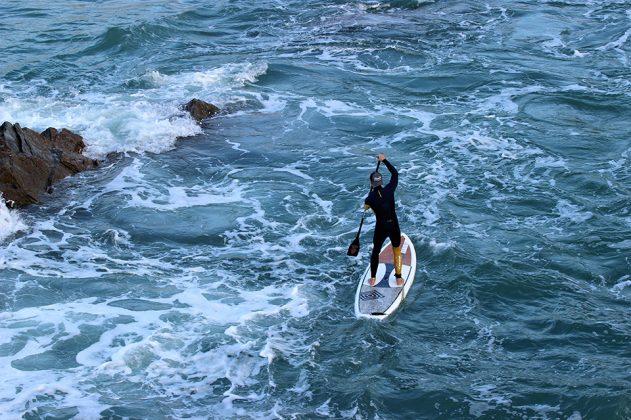PADDLE SCIENCE #9 –
NEUROPLASTICITY
Words – Kate Starling
Ever wondered what neuroplasticity has to do with SUP? Read on…
Cool? Interesting? Geeky? Here are some tantalising brain facts for you:
• The brain contains approximately 100 billion nerve cells, otherwise known as neurons
• Each neuron connects with on average 40,000 synapses
• A piece of brain tissue the size of a grain of sand contains 100,000 neurons and 1 billion synapses which all communicate with each other
• The brain weighs about 2% of the body’s total weight but uses a whopping 20% of the body’s entire oxygen and nutrients
• The brain consists of 73% water – just 2% dehydration can reduce cognition, memory and attention.
‘Cells that Fire Together Wire Together’
The brain consists of a huge ‘web’ of neurons or brain cells which are interconnected by long dendrites which end in axons. These axons connect to other axons via synapses which are small gaps across which electrical impulses and neurotransmitters are exchanged. When two separate neurons fire at the same time, connections will eventually form between the axons, creating pathways within the brain. Neuronal firing and the development of these pathways govern everything we do. It is exactly how we learn, form memories, develop emotions and feelings and are able to do things such as ride a bike and tie our shoelaces.
For decades, scientists believed that the brain was static and unchanging: when one of our many 100 billion nerve cells died, the brain was unable to grow a new cell to replace it. However, the concept of neuroplasticity has turned this theory on its head. Instead, the brain is incredibly dynamic. It is capable of growing new neurons, known as neurogenesis, and has an exceptional ability to continually change, adapt and to learn. This is because, practicing and acquiring different skills not only strengthens existing nerve pathways within the brain but it also encourages new nerve connections and pathways to grow. This is otherwise known as neuroplasticity. This is the brain’s ability to be malleable like plastic and to change and respond to input.
A great example of how the brain learns is to think back to when you first climbed onto your SUP board. The first time, it’s likely that you fell off quite a few times.
The second, third and fourth time it’s likely that you continued to fall off but managed to stay on the board for longer periods of time in between getting wet. The first time you try a new skill, the specific connections between your brain and the relevant muscles for that skill are far from optimal. However, as you begin to learn and acquire a new skill, chemical changes begin to occur within the brain. Neurons begin to connect with each other leading to growth and development of new neuronal pathways. Over time, as you practice a new skill, these new neuronal pathways become increasingly more robust and well defined, driving neuroplastic change within the brain. In relation to sport, as neuroplastic change occurs, it enables more neurons and muscle fibres to be recruited and coordinated in the correct patterns, optimising brain-muscle output and increased physical performance.
“For decades, scientists believed that the brain was static and unchanging: when one of our many 100 billion nerve cells died, the brain was able to grow a new cell to replace it. However, the concept of neuroplasticity has turned this theory on it’s head”
Success, Reward and Neuroplasticity
Neuroplasticity is driven by a variety of different chemicals or neurotransmitters which are exchanged across the synapses between neurons. Without getting too caught up in the science of it all, one neurotransmitter known as brain derived neurotrophic factor (BDNF) increases during neuroplastic change whilst serotonin, the hormone which makes you feel happy, helps to modulate neuroplasticity. Other neurotransmitters include dopamine and epinephrine. These substances are connected with stress, focus and attention. This means that whilst any two neurons have the potential to connect, if the level of hormones tells us that what’s happening is important then these neurons will be more likely to connect. This is exactly why we’re often able to remember unique or shocking events in precise detail. Hormones are the key to why most of us can probably say exactly where we were and what we were doing when 9/11 happened. Dopamine production increases with exercise and in turn helps to increase levels of BDNF. Importantly, dopamine is a hormone linked to ‘reward’. This means that when you successfully manage to stand on your board or make it out of that backhand re-entry, your brain celebrates by releasing dopamine. Your happiness hormone serotonin is also released. This helps to cement the relevant neural pathways which enable you to perform certain movements successfully. Hey presto, neuroplastic change begins to take place.
Boosting Neuroplastic Change
To promote neuroplasticity, you need to consider several things:
• The brain will adapt specifically to the task you give it. Your brain will not therefore adapt to the demands of sup if you choose to go cycling every day. Nor will you become good at surfing if you just paddle on flat water the whole time
• The primary driver of neuroplasticity is PRACTICE!!
• The level of practice required is variable from person to person. Research shows that neuroplastic change requires a minimum of fifteen hours practice over a period of eight weeks to gain any real improvement in skill or performance level
• You can either ‘use it or lose it’. Whilst you can change your brain via what you do you can also conversely change your brain by what you choose not to do. In other words, you may master sup and have driven neuroplastic change in your brain by doing so but if you leave your sup board in the garage for six months and jump back on it half a year later, chances are you’ll feel a little bit rusty getting back out on the water again
• The more you struggle as you practice the more your brain has to adapt and respond. In the same way you need to work your muscles harder to gain strength, you need to continue to challenge your brain to learn new skills
• Did we forget to mention it? Practice. Practice. Practice. Practice is that ultimate cliché but it ultimately makes perfect.
The Athlete Brain and the Beginner Brain
Here’s some interesting brain knowledge. SUP athletes – think Kai Lenny, Robby Naish etc – have practiced various surf and paddle skills so much and for so long that their brains have achieved several things. Their brains have fundamentally:
• Developed and grown the ideal and specific neuronal pathways necessary for SUP
• Structurally reorganised themselves and strengthened these pathways to hone and improve their SUP skills
• Eliminated any pathways which do not allow their SUP skills to be performed well. This is otherwise known as ‘synaptic’ or ‘neuronal pruning’
Synaptic pruning is the ability of the brain to strengthen synapses that are frequently used and to delete or eliminate any unnecessary or weak neural connections. One example is paddle surfing where a common mistake is to hinge at the hips instead of the knees and ankles when compressing. Synaptic pruning would ideally occur as you practice your compression skills in order to delete any pathways which encourage you to bend at your hips and to strengthen the pathways which encourage you to bend at the knees instead. Ultimately pruning seeks to help reduce mistakes, enhancing your performance at your chosen skill. Interestingly, any elite athlete will demonstrate fewer neuronal pathways for their chosen sport or skill compared to a beginner. Due to a lack of practice and a lower level of ‘synaptic pruning’, a beginner will not have adequately defined the perfect pathway for that skill. This isn’t a negative thing. It just means that through practice, the vast majority of us have got huge potential for improving our neural pathways and SUP ability.
We’re so used to thinking about things such as core stability, muscle strength and flexibility when it comes to paddling that the major and most significant driver behind all of our sup skills – the brain – is often overlooked. The brain’s ability to change and respond to input is an infinite and remarkable thing. Neuroplastic change will happen involuntarily every time you set about learning a new skill – start tapping into your brain’s potential and see how far this extraordinarily complex organ can take you. SUP
Kate is a physiotherapist and standup paddler. Reach her at www.newquayphysio.co.uk


